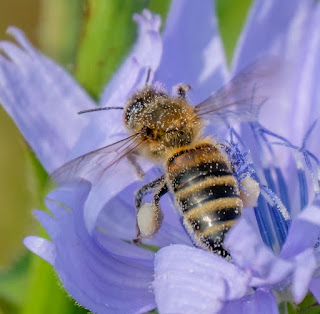First a Common Darter that has perished in the pond and is being consumed by all stages of Pond Skaters from very small juveniles to an unusual trio - the top one couldn't reach the prey so this did not last long.
The Leaf-cutter Bees have made holes in all our rose bushes and are busy stuffing their nest tubes with leaves. They glue them together with saliva in order to build the 'cells'. Each cell contains a ball or loaf of stored pollen and a single egg. The larvae hatch and develop, pupating in autumn and hibernating over winter.
Even more curious is this fly found when photographing a bee wrapped in a Garden Spider web. It belongs to the Milichiidae family (J
ackal Flies). The adults of some species act as
kleptoparasites, feeding on bodily fluids of the prey of various invertebrates including spiders. They penetrate the thinnest cuticle of a bee in a spider's web, extracting tissues that the enzymes in the venom of the spider have reduced to a fluid state. The "jackal" habit has been widely documented, with many pictures and references to Millichiidae assembling on the prey of spiders. However, they are fussy and most prey insects do not attract Milichiidae - they seem only to follow the scents exuded by killed prey such as Hemiptera, Heteroptera, and Hymenoptera. It is suggested that their chosen 'host' hunt prey that release a dramatic and characteristic olfactory signal. In support of this, some species seem to operate in the dark, and photographs of approaching flies seem to show them flying upwind. I haven't found any information on how they avoid getting stuck to the web!!



























































